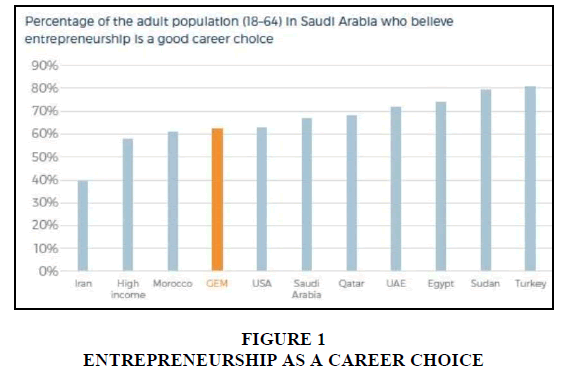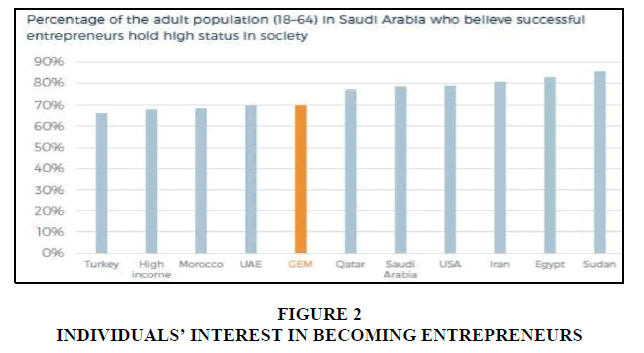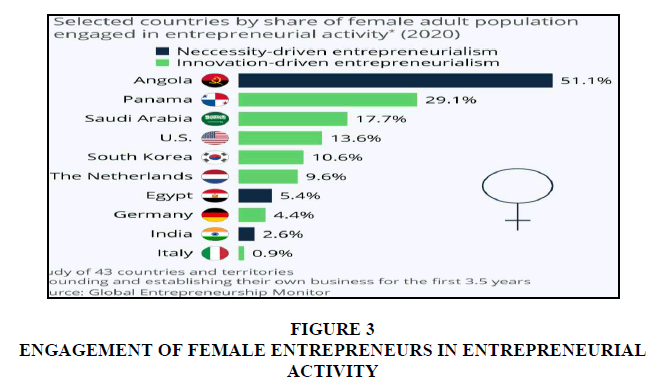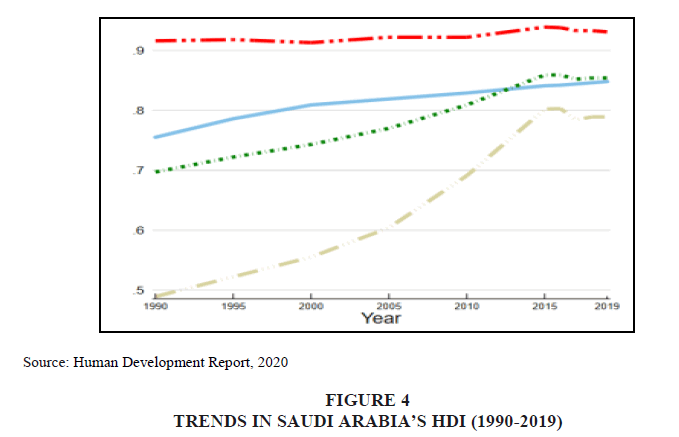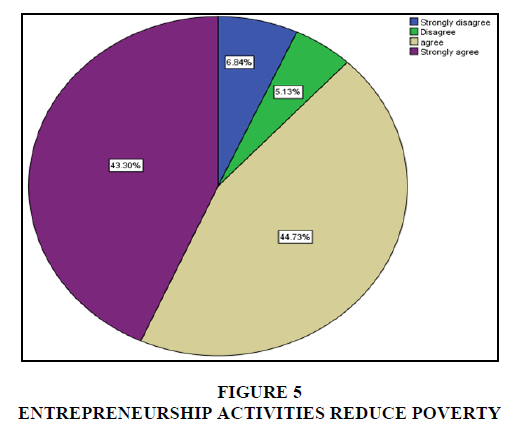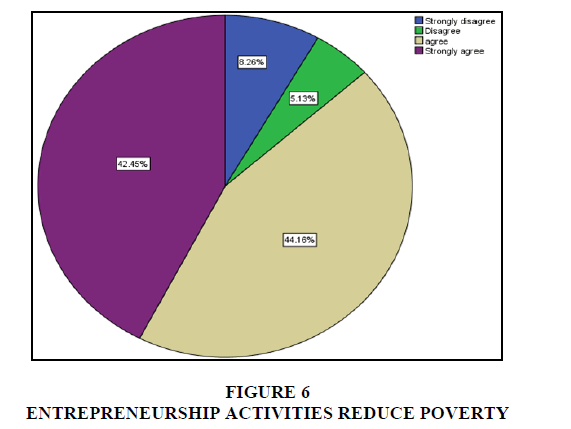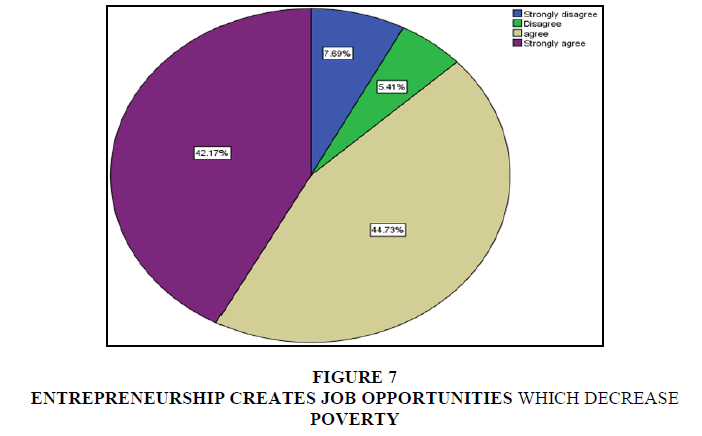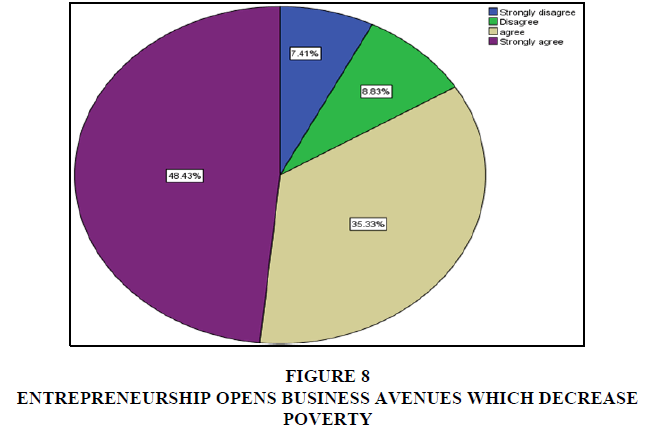Research Article: 2022 Vol: 26 Issue: 4
Entrepreneurs perceptions towards the dynamic role of entrepreneurship in overcoming poverty
Nadia A. Abdelmegeed Abdelwahed, King Faisal University
Mohammed A. Al Doghan, King Faisal University
Citation Information: Abdelwahed, N.A.A., & Al Doghan, M.A. (2022). Entrepreneurs’ perceptions towards the dynamic role of entrepreneurship in overcoming poverty. International Journal of Entrepreneurship 26(4), 1-13.
Abstract
Currently, severe poverty is a problem worldwide and this is especially so in developing countries. In this regard, this study aimed to identify the entrepreneurs’ perceptions of eliminating poverty through entrepreneurship activities. In this study, the researcher employed a cross-sectional approach to obtaining data through a survey questionnaire. The researcher selected relevant entrepreneurs as study participants. They applied SPSS to analyze the data. By employing the contingency table, Person’s correlation and multiple regression, the study's findings highlight that entrepreneurship has a positive and significant effect of on reducing poverty. In addition, the findings demonstrate further that entrepreneurship activities are the key to generating income. Such activities create job opportunities which provide support and, thereby, help to reduce the numbers of people caught in the poverty trap. The study's findings highlight the need for policymakers to deliver the government guidelines to increase entrepreneurship and, consequently, reduce unemployment and the level of poverty. Further, this study’s findings show that the promotion of entrepreneurship opens new pathways for businesses which, in turn, can reduce meaningfully the intolerable situations of poverty. Lastly, in the Saudi Arabian context, this study's findings enrich the depth of the empirical literature on this topic.
Keywords
Entrepreneurship, Poverty Alleviation, Entrepreneurs’ Perceptions, Income; Job Opportunities, Avenues.
Introduction and Background
Presently, the reduction of poverty has become an essential issue for all segments of the government and the community. Such matters have created a lot of concerns and challenges for management, social sciences, economics and finance and entrepreneurship researchers (Soomro & Shah, 2015; Dollar et al., 2016; Chen et al., 2017; Shah & Soomro, 2017; Sutter et al., 2019). Generally, poverty is conceptualized as the lack of basic needs (food, clothing and shelter), the lack of productive resources and the lack of health and education (Olayemi, 2012). Different measures have been taken to overcome the extreme situation of poverty. Microfinance, education, poverty alleviation programs and foreign aid programs are significant initiatives to control such issues (Ali et al., 2013; Alvarez et al., 2015; Si et al., 2020). Unfortunately, these initiatives have not made a significant impact in eradicating poverty (Easterly, 2006; Roodman, 2012; Amorós et al., 2021). Therefore, in this study, the researchers have attempted to connect economic growth with the alleviation of poverty through entrepreneurship and digital technological modes (Bloom et al., 2013; Ahlstrom, 2015; McCloskey, 2016; Soomro & Shah, 2021; Lakhan et al., 2021; Soomro et al., 2021). The quick and widespread economic growth has resulted in taking many poor people above the poverty line and, more particularly, three has been a 10% reduction in the rate of poverty (Ahlstrom, 2010; Dollar et al., 2016; Roser & Ortiz-Ospina, 2017). Nonetheless, it is unmistakable that several regions and economies have seen dramatic changes in attempts to control and overcome the levels of poverty. Globally, entrepreneurship has remained a valuable tool among the measures to alleviate poverty (Collier, 2007; Amorós et al., 2021). Entrepreneurship has provided a process that embraces individuals’ efforts to recognize practicable business opportunities in a milieu along with the procurement and handling of the resources required to exploit these opportunities. According to Timmons & Spinelli (2004), entrepreneurship activity is an underlying force which twitches the “creative destruction” and which is the spirit of economic development.
Consequently, in considering the significant role of entrepreneurship in reducing poverty, the researcher attempted in this study to explore the entrepreneurs’ perceptions regarding the contribution of entrepreneurship towards the alleviation of poverty in Saudi Arabia. They hoped that this study’s findings would provide significant ways to tackling the intolerable effects of poverty.
Relationship Between Entrepreneurship And Poverty
Entrepreneurship is the process of starting a new business; taking risks; and providing new income opportunities (Bloom et al., 2016; Lakhan et al., 2021; Soomro & Shah, 2021). These dimensions can be achieved through the application of different methods and modes. Likewise, poverty is the unavailability of education, health and basic needs, i.e. food, clothing and shelter (Olayemi, 2012; Si et al., 2020). In this regard, there is a positive and significant association between both elements (entrepreneurship and poverty). According to numerous scholars like Bloom et al. (2013); Ahlstrom (2015); Bloom et al. (2016) and McCloskey (2016), economic growth through the support of entrepreneurship and the adaptation of new techniques and technologies has a significant connection with the alleviation of poverty alleviation. Accordingly, entrepreneurship is a liable engine that makes a significant contribution by addressing the challenges to reduce poverty by means of financial aid, microfinance and using different measures to take action against the dangerous poverty traps (Easterly, 2002; Whitacre et al., 2019). Some studies’ findings have demonstrated that economic growth can make a tremendous difference to taking above the poverty line poor people who account for 10% of the world’s population (Dollar et al., 2016; Roser & Ortiz-Ospina, 2017). Nonetheless, in some regions, the findings show that there has been no significant reduction in the level of poverty and that many people continue to suffer in the vicious poverty trap. This ratio highlighted 630 million populations in 2018. In the opinion of Bruton et al. (2013); Bruton et al. (2015); Sutter et al. (2019), entrepreneurship reduces the ratio of poverty significantly in the different economies. It provides raw materials, new goods and services, markets and introduces and organizes new modes and means of production (Shane & Venkataraman, 2000; Eckhardt & Shane, 2003). Undeniably, entrepreneurship brings about radical changes on all sides in the fields of new ventures and innovation (Denning, 2016). These encompass institutional and social spheres that improve the social status of poor people and enhance social entrepreneurship (Rindova et al., 2009).
Consequently, the literature provides evidence of entrepreneurship through microfinance, income generation programs, crowdfunding, and social well-being as representing a solution to poverty. Therefore, the researcher concludes that entrepreneurship is the robust solution to reducing poverty and that the entrepreneurs’ perceptions are determined in this regard.
Entrepreneurship And Poverty Trends In Saudi Arabia
Entrepreneurship is regarded as a process of grasping an opportunity by introducing new modes of products and services which have real monetary value in the economy (Szycher, 2014). Entrepreneurship makes a significant impact on the country's socioeconomic well-being (Soomro & Shah, 2021). It improves the entrepreneurs’ economic and social circumstances (Lumpkin et al., 2013). The positive entrepreneurship culture opens significant pathways and enables entrepreneurs to launch new ventures and to provide employment opportunities. Notably, in emerging markets, an entrepreneurial culture is a protagonist factor that subdues unemployment and boosts the economy properly (Nkechi et al., 2012).
In Saudi Arabia, the Government is taking an interest in boosting entrepreneurship. More specifically, the Saudi Arabian Government in its Saudi Vision 2030 tries to create a healthy entrepreneurial environment through developing entrepreneurial attitudes and intentions (Abdulghaffar & Akkad, 2021). Previously, there has been attempts to enlarge entrepreneurship in prosperous Saudi Arabia. The Saudi Arabian citizens have attempted to overcome the problems to become predictable suppliers. However, in Saudi Arabia, despite the country’s high rate of unemployment (Wijaya & Budiman, 2012) and barriers of conventional thinking and the quality of education (Al-Eisa & Smith, 2013), entrepreneurship is still in its infancy.
According to the GEM Saudi Arabia National Report (2018/19), 83% of Saudi Arabian adults are highly confident in their abilities to commence a business. These individuals favor the development of a positive entrepreneurship culture to fulfil and strengthen the country’s Vision 2030. About 68% of the Saudi Arabian adult population believes that entrepreneurship is vital for their career choices (Figure 1), and about 78% have developed an interest in becoming entrepreneurs (Figure 2).
According to Alessa and Alajmi (2017), project contribution has a positive effect on the likelihood of Saudi Arabians becoming entrepreneurs. According to the Global Entrepreneurship Monitor (2020), 17.17% of female entrepreneurs are engaged in entrepreneurial activity and innovation-driven by Saudi Arabia’s entrepreneurialism (Figure 3).
In encouraging more rapid entrepreneurship in Saudi Arabia, part of the political agenda is the empowerment of women. However, training and development is the core issue ranked by social entrepreneurs. The Saudi Arabian Government has made serious efforts to achieve an entrepreneurship culture by reducing taxes and regulations and by providing access to funding and education and training (Nieva, 2015).
Furthermore, poverty is the second most dominant issue in Saudi Arabia. It is prevalent in old neighborhoods of wealthy municipalities and mainly among women (Krane, 2015; Alfahad, 2015). Women face such problems due to scarce opportunities, nonexistence of education and social stigma (Krane, 2015). Saudi society confines the activities of women except when accompanied by male custodians. In Middle Eastern countries in 2017, Saudi Arabia had the lowest reported rate of poverty and at 12.7% had the 10th lowest rate of poverty in the world. The Human Development Reports shows that Saudi Arabia’s GNI per capita income increased significantly from 1990 to 2019 (Figure 4). According to Thelwell, Prince Salman has faith in addressing unemployment and poverty and has made it a priority to do so on humanitarian and economic grounds. He believes, also, that Saudi Arabia would attract more foreign investment by expanding the country’s economy and controlling the rates of unemployment and poverty.
Methods
The researcher used the deductive approach for this study in view of its frequent use in the entrepreneurship context (Liñán & Chen, 2009; Soomro & Shah, 2021). Also, in the Saudi Arabian context, several other scholars, such as Kayed and Hassan (2011), Khan (2013), Alayis and Abdelwahed (2018), have used this approach to examine the country’s citizens’ attitudes towards entrepreneurship and their entrepreneurial intentions. The researcher based this study on cross-sectional data and used a snowball sampling technique to collect the data t by means of a survey questionnaire. For this study, the researcher adopted the scale items from the domain literature and assigned the five-point Likert scale, which starts from strongly disagree to strongly agree, to each item. This study’s respondents were entrepreneurs engaged in the different entrepreneurial activities and who had escaped the poverty trap through their promotion of entrepreneurship activities and small businesses. This study examined the following four perceptions: namely, “Entrepreneurship activities reduce poverty”; “Entrepreneurship activities increase income”; Entrepreneurship creates job opportunities, which decrease poverty; and “Entrepreneurship opens business avenues, which decrease poverty”. These perceptions gave an indication of the entrepreneurs’ views on the connection between entrepreneurship and poverty.
Before seeking their responses, the researcher made the respondents fully aware of this study’s aim and objectives and that their responses would be used only for educational and research purposes. The researcher assured them, also, about the confidentiality and privacy of their demographic information. At the outset, the researcher distributed 550 surveys to the entrepreneurs. In return, she received 351 valid cases which represented a 63% response rate. The researcher applied, also, a single measure item technique with the aim of finding out the entrepreneurs' perceptions regarding the role of entrepreneurship in the alleviation of poverty. She analyzed a contingency table based on a single item measure (Hair et al., 2017). This study’s findings show that there is a much larger number of male than female entrepreneurs. This is due to Saudi Arabia having a predominantly male society since usually women are usually restricted to their homes.
Results
Demography of Respondents
The demographic profile of the respondents shows that most male entrepreneurs (n=296 or 84%) than female entrepreneurs (n=55 or 15%) (see Table 1). Likewise, most respondents were found to be married (n=230 or 65%) as compared to being single or bachelors (n=121 or 34%) (Table 1). Turning to the respondents’ ages, a massive number were between 26-40 years of age (n=202 or 57%). 66 (18%) individuals were < 25 years of age. Finally, the researcher observed that only 83 (23%) entrepreneurs were forty-one years of age and above (Table 1).
| Table 1 Demographic Details |
|||
|---|---|---|---|
| Variable | Category | Frequency | Percentage (%) |
| Gender | Male | 296 | 84.33 |
| Female | 55 | 15.67 | |
| Total | 351 | 100.0 | |
| Marital status | Single | 121 | 34.47 |
| Married | 230 | 65.53 | |
| Total | 351 | 100.0 | |
| Age | < 25 years | 66 | 18.80 |
| 26-40 years | 202 | 57.55 | |
| 41 years and above | 83 | 23.65 | |
| Total | 351 | 100.0 | |
Contingency Analysis
Most respondents (44% n=157) agreed with the first perception that “Entrepreneurship activities reduce poverty”. Also, 43% were found to strongly agree with the perception that “Entrepreneurship opens business avenues, which decrease poverty”. On the other hand, a lower ratio of entrepreneurs (n=24 or 6%) stated that they disagreed with this statement. Finally, we found only 5% (n=18) disagreed with statement (Table 2 and Figure 5). Henceforth, the analysis of their responses suggests that entrepreneurship plays a protagonist role of in reducing poverty among the entrepreneurs.
| Table 2 Entrepreneurship Activities Reduce Poverty |
|||||
|---|---|---|---|---|---|
| Frequency | Percent | Valid Percent | Cumulative Percent | Decision | |
| Strongly disagree | 24 | 6.8 | 6.8 | 6.8 | Agree |
| Disagree | 18 | 5.1 | 5.1 | 12.0 | |
| Agree | 157 | 44.7 | 44.7 | 56.7 | |
| Strongly agree | 152 | 43.3 | 43.3 | 100.0 | |
| Total | 351 | 100.0 | 100.0 | ||
During the survey, most of the entrepreneurs showed their agreement with the statement: “Entrepreneurship activities increase income”, which yields 44% (n=155) (see Table 3 and Figure 6). In addition, 149 (42%) entrepreneurs strongly agreed that entrepreneurship significantly increased the individuals’ incomes. On the other hand, this study’s findings show that an insufficient number of entrepreneurs disagreed with the perception. 29 (8%) strongly disagreed and 18 (5%) disagreed with the same statement (Table 3 and Figure 6). Therefore, from this study’s findings the researcher concludes that entrepreneurship activities are the potent factor that substantially increase the entrepreneurs' incomes.
| Table 3 Entrepreneurship Activities Increase Income |
|||||
|---|---|---|---|---|---|
| Frequency | Percent | Valid Percent | Cumulative Percent | Decision | |
| Strongly disagree | 29 | 8.3 | 8.3 | 8.3 | Agree |
| Disagree | 18 | 5.1 | 5.1 | 13.4 | |
| Agree | 155 | 44.2 | 44.2 | 57.5 | |
| Strongly agree | 149 | 42.5 | 42.5 | 100.0 | |
| Total | 351 | 100.0 | 100.0 | ||
Furthermore, the third perception reveals that most of the entrepreneurs (44%; n=157) (Table 4 and Figure 7) agreed that entrepreneurship had a positive and significant effect in creating employment opportunities. Ultimately, these initiatives reduce poverty enormously among individuals. In addition, this study’s findings show that 148 (42%) entrepreneurs highlighted that entrepreneurship was the reliable source of employment (Table 4 & Figure 7). On the other hand, he 27 (7%) entrepreneurs strongly disagreed with the perception that entrepreneurship created jobs. Lastly, only 19 (5%) respondents disagreed with the entrepreneurship perception in respect of job creation. Consequently, the data confirmed that entrepreneurship created meaningful job opportunities that were favorable to reducing poverty.
| Table 4 Entrepreneurship Creates Job Opportunities Which Decrease Poverty |
|||||
|---|---|---|---|---|---|
| Frequency | Percent | Valid Percent | Cumulative Percent | Decision | |
| Strongly disagree | 27 | 7.7 | 7.7 | 7.7 | Agree |
| Disagree | 19 | 5.4 | 5.4 | 13.1 | |
| Agree | 157 | 44.7 | 44.7 | 57.8 | |
| Strongly agree | 148 | 42.2 | 42.2 | 100.0 | |
| Total | 351 | 100.0 | 100.0 | ||
Similarly, this study’s findings about the final perception reveal that entrepreneurship is a valuable source that open new pathways for business (n=170 or 48%) (Table 5 and Figure 8). These findings show that 35% (n=124) of entrepreneurs agreed with the statement “Entrepreneurship opens business avenues, which decrease poverty”. In contrast, 31 (8%) entrepreneurs disagreed and 26 (7%) strongly disagreed with the statement and did not believe that business had a significant role in reducing poverty. Consequently, this study’s findings show that, overall, most entrepreneurs either disagreed or strongly disagreed with the perception that entrepreneurship opened new pathways for business and, therefore, eradicated poverty among them.
| Table 5 Entrepreneurship Opens Business Avenues Which Decrease Poverty |
|||||
|---|---|---|---|---|---|
| Frequency | Percent | Valid Percent | Cumulative Percent | Decision | |
| Strongly disagree | 26 | 7.4 | 7.4 | 7.4 | Stronglyagree` |
| Disagree | 31 | 8.8 | 8.8 | 16.2 | |
| Agree | 124 | 35.3 | 35.3 | 51.6 | |
| Strongly agree | 170 | 48.4 | 48.4 | 100.0 | |
| Total | 351 | 100.0 | 100.0 | ||
Descriptive Statistics and Correlation Coefficients
The researcher used descriptive statistics to indicate the trends in the respondents’ views. The range of mean was found between 3.019-3.675 (Table 6) with maximum mean scores for business ventures (3.675) and minimum for poverty reduction (3.019). Likewise, standard deviation values showed that the maximum value for entrepreneurship activities was 1.204 and that the minimum value for job opportunities was 0.867 (Table 6). Finally, the researcher found positive and significant correlations among all the constructs and she observed no multicollinearity in the data.
| Table 6 Descriptive Statistics And Correlation Coefficients |
||||||||
|---|---|---|---|---|---|---|---|---|
| Variables | Mean | Std. Deviation | 1 | 2 | 3 | 4 | 5 | |
| 1 | Entrepreneurship activities | 3.035 | 1.204 | --- | ||||
| 2 | Income | 3.005 | 0.147 | 0.335** | --- | |||
| 3 | Poverty reduction | 3.019 | 0.945 | 0.432** | 0.329** | --- | ||
| 4 | Job opportunities | 3.202 | 0.867 | 0.497** | 0.375** | 0.299** | --- | |
| 5 | Business avenues | 3.675 | 1.067 | 0.354** | 0.389** | 0.379** | 0.308** | --- |
| Note: ** Correlation is significant at the 0.01 level (2-tailed); * Correlation is significant at the 0.05 level (2-tailed). |
||||||||
Multiple Regression Analysis
Finally, the researcher applied multiple regression through SPSS version 26.0 to confirm the effects of statements on the dependent statements. She used Beta (β) values and significance level <0.01** to observe the impact of the constructs. The analysis showed that entrepreneurship activities had a positive and significant effect on reducing poverty (β=0.259**), income (β=0.335**), job opportunities (β=0.299**) and business avenues (β=0.389**) (see Table 7). Besides, the study found R2=0.369; adjusted R2=0.398; and F value (29.893) (Table 7). Consequently, the data supported all the perceptions proposed by the researcher.
| Table 7 Multiple Regression |
||||
|---|---|---|---|---|
| Predictor | Dependent variable (poverty reduction) β |
Dependent variable (income) Β |
Dependent variable (job opportunities) β |
Dependent variable (business avenues) β |
| Entrepreneurship activities | 0.259** | 0.335** | 0.299** | 0.389** |
| R2 | 0.369 | |||
| Adjusted R2 | 0.398 | |||
| F value | 29.893 | |||
| Note: p*<0.10; p**<0.05 | ||||
Discussion and Conclusion
The context of this study was Saudi Arabian entrepreneurs of who through promoting their entrepreneurship activities, had escaped from the vicious poverty trap. The purpose of this study was to investigate the entrepreneurs’ perceptions about entrepreneurship’s significant role in reducing poverty. To achieve this study’s objective, the study gathered cross-sectional data from the entrepreneurs. As supported from reviewing the previous literature, the researcher used a deductive approach for this study. To interpret the data, the researcher employed a contingency table to measure such perceptions. In their responses to the first perception relating to entrepreneurship activities towards the reduction of poverty, the entrepreneurs stated their agreement. This outcome is consistent with the findings of various scholars, such as Si et al. (2020) and Amorós et al. (2021), whose findings claim that entrepreneurship activities are responsible for eliminating poverty. In addition, the contingency table further highlighted their agreement with the statement that entrepreneurship activities increased their incomes. These findings are consistent with those of Ranyane (2015); Shah and Soomro (2017) who found the positive predictive power of entrepreneurship and business on income generation. In this manner, entrepreneurship has the potential to generate income along with creating employment.
On the other hand, these positive perceptions are inconsistent with Lecuna’s (2019) findings who claimed that high-aspiration entrepreneurs were unaffected. Moreover, total entrepreneurial activity capacity is a crucial factor in amplifying the variations found in income inequality. Furthermore, this study’s findings show that entrepreneurship creates job opportunities which decrease poverty. More specifically in the context of developing countries, previous findings by such as Si et al. (2002); Soomro and Shah (2021) supports these entrepreneurs’ perceptions. According to Saudi Arabian entrepreneurs of, entrepreneurship opens significant new avenues of employment and self-employment through the startup of small businesses. Concerning the opening of corporate paths, these work as building blocks in the meaningful elimination of poverty from society.
In conclusion, this study’s findings suggest that entrepreneurial activities have a significant effect in reducing poverty; generating income and employment opportunities; and opening new avenues of employment through involvement in business and venture creation. This study’s findings provide guideline to policymakers, planners and government agents to boost the entrepreneurship environment in creating employment opportunities and thereby, reducing the evils of unemployment and poverty in the community. In addition, these findings help to promote entrepreneurial activities that are predominantly successful in reducing income inequality in society. Moreover, the outcomes offer the novel presentations and open a new theoretical perspective on entrepreneurship’s relationship with poverty (Lecuna, 2019). Finally, this study's findings contribute to the literature on entrepreneurship and poverty and, more particularly, in the context of Saudi Arabia.
The researcher experienced a few limitations in conducting this study based on cross-sectional data. For this study, the researcher employed a survey questionnaire that consisted of a single item estimation. The researcher did not apply any specific theory to underpin the conceptualization of this study. The data analysis was restricted to descriptive statistics, contingency tables, Person’s correlation and multiple regression. Consequently, the researcher recommends that, in the future, more longitudinal studies be conducted to examine entrepreneurs' different perceptions regarding the successes and failures of their businesses. The researcher considers that such theories are needed to further extend the conceptualization.
Acknowledgement
This work was supported by the Deanship of Scientific Research, Vice Presidency for Graduate Studies and Scientific Research, King Faisal University, Saudi Arabia [Project No. AN00044].
References
Abdulghaffar, N.A.., & Akkad, G.S. (2021). Internal and external barriers to entrepreneurship in Saudi Arabia. DOMES Digest of Middle East Studies, 30(2), 116-134
Indexed at, Google Scholar, Crossref
Ahlstrom, D. (2010). Innovation and growth: How business contributes to society. The Academy of Management Perspectives, 24(3), 10-23.
Indexed at, Google Scholar, Crossref
Ahlstrom, D., & Austrian Council for Research and Technology Development. (2015). Innovation and growth in emerging economies. Austrian Council for Research and Technology Development (Ed.). Designing the future: Economic, societal, and political dimensions of innovation, 353-387.
Alayis, M.M.H., & Abdelwahed, N.A.A. (2018). Impact of social networking sites’ use on entrepreneurial intention among undergraduate business students: The case of Saudi Arabia. International Journal of Entrepreneurship, 22(4), 1-18.
Al-Eisa, E. S., & Smith, L. (2013). Governance in Saudi higher education. In L. Smith & A. Abouammoh (Eds.), Higher education in Saudi Arabia. Dordrecht, Springer, The Netherlands, 27-35.
Indexed at, Google Scholar, Crossref
Alessa, A.A., & Alajmi, S.H. (2017). The development of Saudi Arabian entrepreneurship and knowledge society. International Journal of Management Excellence, 9(3), 1155-1168.
Indexed at, Google Scholar, Crossref
Alfahad, A. (2015). Saudi broadcast interviews: Moving towards aggressiveness. Discourse & Communication, 9(4), 387-406.
Indexed at, Google Scholar, Crossref
Ali, B., Shah, N., Bhatti, M.K., & Zehri, A.W. (2013). The role of wellbeing for poverty alleviation: A conceptual study. Balochistan Review, 29(2), 1-12.
Alvarez, S.A., Barney, J.B., & Newman, A.M.B. (2015). The poverty problem and the industrialization solution. Asia Pacific Journal of Management, 32(1), 23-37.
Indexed at, Google Scholar, Crossref
Amorós, J.E., Ramírez, L.M., Rodríguez-Aceves, L., & Ruiz, L.E. (2021). Revisiting poverty and entrepreneurship in developing countries. Journal of Developmental Entrepreneurship, 26(2), 2150008.
Indexed at, Google Scholar, Crossref
Bloom, N., Draca, M., & Van Reenen, J. (2016). Trade induced technical change? The impact of Chinese imports on innovation, IT and productivity. The Review of Economic Studies, 83(1), 87-117.
Indexed at, Google Scholar, Crossref
Bloom, N., Eifert, B., Mahajan, A., McKenzie, D., & Roberts, J. (2013). Does management matter? Evidence from India. The Quarterly Journal of Economics, 128(1), 1-51.
Indexed at, Google Scholar, Crossref
Bruton, G.D., Ketchen Jr, D.J., & Ireland, R.D. (2013). Entrepreneurship as a solution to poverty. Journal of Business Venturing, 28(6), 683-689.
Indexed at, Google Scholar, Crossref
Bruton, G.D., Khavul, S., Siegel, D., & Wright, M. (2015). New financial alternatives in seeding entrepreneurship: Microfinance, crowdfunding, and peer-to-peer innovations. Entrepreneurship Theory and Practice, 39(1), 9-26.
Indexed at, Google Scholar, Crossref
Chen, J., Chang, A.Y., & Bruton, D.D. (2017). Microfinance: Where are we today and where should the research go in the future? International Small Business Journal, 35(7), 793-802.
Indexed at, Google Scholar, Crossref
Collier, P. (2007). The bottom billion. Economic Review-Deddington-, 25(1), 17.
Denning, S. (2016). Christensen updates disruption theory. Strategy & Leadership, 44(2), 10-16.
Indexed at, Google Scholar, Crossref
Dollar, D., Kleineberg, T., & Kraay, A. (2016). Growth still is good for the poor. European Economic Review, 81, 68-85.
Indexed at, Google Scholar, Crossref
Easterly, W. (2002). The elusive quest for growth: Economists’ adventures and misadventures in the tropics. Cambridge, MA: MIT Press.
Easterly, W. (2006). The white man’s burden: Why the West’s efforts to aid the rest have done so much Ill and so little good. Penguin Press, New York.
Eckhardt, J., & Shane, S. (2003). Opportunities and entrepreneurship. Journal of Management, 29 (3), 333-349.
Indexed at, Google Scholar, Crossref
Hair, J.F., Hult, G.T.M., Ringle, C.M., & Sarstedt, M. (2017). A primer on partial least squares structural equation modelling (PLS-SEM). 2nd ed. Thousand Oaks, CA: Sage.
Kayed, R.N., & Hassan, K.M. (2011). Saudi Arabia's economic development: Entrepreneurship as a strategy. International Journal of Islamic and Middle Eastern Finance and Management, 4(1), 52-73.
Indexed at, Google Scholar, Crossref
Khan, R.M. (2013). Mapping entrepreneurship ecosystem of Saudi Arabia. World Journal of Entrepreneurship, Management and Sustainable Development, 9(1), 28-54.
Indexed at, Google Scholar, Crossref
Krane, J. (2015). A refined approach: Saudi Arabia moves beyond crude. Energy Policy, 82, 99-104.
Indexed at, Google Scholar, Crossref
Lakhan, G.R., Soomro, B.A., & Channa, A. (2021). Problems and restrictions perceived by the potential entrepreneurs in a developing context. Psychology and Education, 58(5), 3102-3110.
Lecuna, A. (2019). Income inequality and entrepreneurship. Economic Research-Ekonomska Istrazivanja, 33(1), 1-17.
Indexed at, Google Scholar, Crossref
Liñán, F., & Chen, Y. (2009). Development and cross-cultural application of a specific instrument to measure entrepreneurial intentions. Entrepreneurship Theory and Practice, 33(3), 593-617.
Indexed at, Google Scholar, Crossref
Lumpkin, G.T., Moss, T.W., Gras, D.M., Kato, S., & Amezcua, A.S. (2013). Entrepreneurial processes in social contexts: How are they different, if at all? Small Business Economics, 40(3), 761-783.
Indexed at, Google Scholar, Crossref
McCloskey, D.N. (2016). Bourgeois Dignity: How Ideas, Not Capital or Institutions, Enriched the World. A World Transformed: Studies in the History of Capitalism, Vol. Two. London: Legatum Institute, 30-37.
Nieva, F.O. (2015). Social women entrepreneurship in the Kingdom of Saudi Arabia. Journal of Global Entrepreneurship Research, 5(11).
Indexed at, Google Scholar, Crossref
Nkechi, A., Emeh Ikechukwu, E.J., & Okechukwu, U.F. (2012). Entrepreneurship development and employment generation in Nigeria: Problems and prospects. Journal of Education and General Studies, 1(4), 88-102.
Olayemi, J.K. (1995). A survey of approaches to poverty alleviation. In A Paper Presented at the NCEMA National Workshop on Integration of Poverty Alleviation Strategies into Plans and Programmes in Nigeria, Ibadan.
Ranyane, K.A. (2015). Survivalist entrepreneurship: An income generating alternative for the unemployed populace. Mediterranean Journal of Social Sciences, 6(4), 301-306.
Indexed at, Google Scholar, Crossref
Rindova, V., Barry, D., & Ketchen, J.D.J. (2009). Entrepreneuring as emancipation. Academy of Management Review, 34(3), 477-491.
Indexed at, Google Scholar, Crossref
Roodman, D. (2012). Due diligence: An impertinent inquiry into microfinance. CGD Books.
Roser, M., & Ortiz-Ospina, E. (2017). Global extreme poverty-Our World In Data.
Shah, N., & Soomro, B.A. (2017). Investigating entrepreneurial intention among public sector university students of Pakistan. Education + Training, 59(7/8), 841-855.
Indexed at, Google Scholar, Crossref
Shane, S., & Venkataraman, S. (2000). The promise of entrepreneurship as a field of research. Academy of Management Review, 25(1), 217-226.
Indexed at, Google Scholar, Crossref
Soomro, B.A., & Shah, N. (2015). Developing attitudes and intentions among potential entrepreneurs. Journal of Enterprise Information Management, 28(2), 304-322.
Indexed at, Google Scholar, Crossref
Soomro, B.A., & Shah, N. (2021). Technopreneurship intention among non-business students: A quantitative assessment. World Journal of Entrepreneurship, Management and Sustainable Development, 17(3), 502-514.
Indexed at, Google Scholar, Crossref
Soomro, B.A., Mangi, S., & Shah, N. (2021). Strategic factors and significance of organizational innovation and organizational learning in organizational performance. European Journal of Innovation Management, 24(2), 481-506.
Indexed at, Google Scholar, Crossref
Si, S., Ahlstrom, D., Wei, J., & Cullen, J. (2020). Business, entrepreneurship and innovation toward poverty reduction. Entrepreneurship & Regional Development, 32(1-2), 1-20.
Indexed at, Google Scholar, Crossref
Sutter, C., Bruton, G.D., & Chen, J. (2019). Entrepreneurship as a solution to extreme poverty: A Review and future research directions. Journal of Business Venturing, 34(1), 197-214.
Indexed at, Google Scholar, Crossref
Timmons, J.A., Spinelli, S., & Tan, Y. (2004). New venture creation: Entrepreneurship for the 21st century (6th Edn.). New York: McGraw-Hill/Irwin.
Whitacre, B.E., Meadowcroft, D., & Gallardo, R. (2019). Firm and regional economic outcomes associated with a new, broad measure of business innovation. Entrepreneurship & Regional Development, 31(9-10), 930-952.
Indexed at, Google Scholar, Crossref
Wijaya, T., & Budiman, S. (2013). The testing of entrepreneur intention model of SMK students in special region of Yogyakarta. Journal of Global Entrepreneurship, 4(1), 1-16.
Received: 22-Apr-2022, Manuscript No. IJE-22-11832; Editor assigned: 25-Apr-2022, PreQC No. IJE-22-11832(PQ); Reviewed: 16-May-2022, QC No. IJE-22-11832; Revised: 19-May-2022, Manuscript No. IJE-22-11832(R); Published: 26-May-2022
